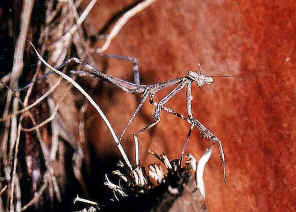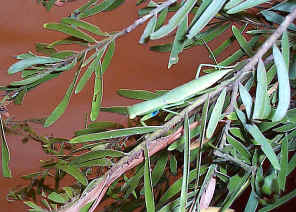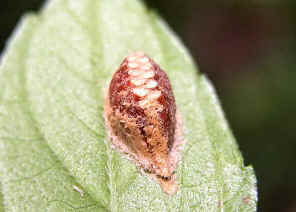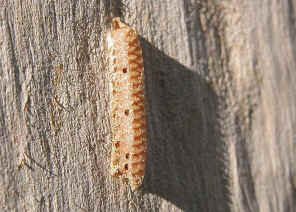Praying Mantids - Order Mantodea
This page contains pictures and information about praying mantids, or praying mantis, that we found in the Brisbane area, Queensland, Australia.
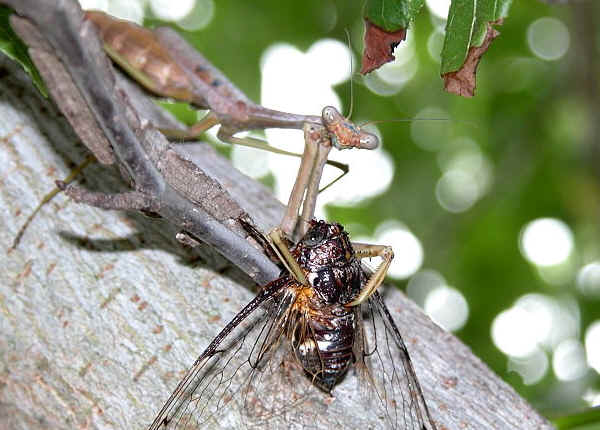
- Praying Mantid - The Predator
Praying Mantids are from medium to large size insects. They are predators to other insects, with strong forelegs which have spines in between. Most mantids usually sit and wait among the vegetation ready to grasp unsuspecting prey by their powerful forelegs. They wait motionless with their forelegs together and this gave them their name of Praying Mantids.
Praying Mantids have strong mouthparts for chewing, together with their large eyes well apart on each side, form their mobile triangular head. Their antennae are slender, segmented and longer in male than in female. They have hardened forewings for protection and membranous hind wings for flying, although some species are wingless. They develop with in-complete metamorphosis.
Usually Praying Mantids are green or light brown in colour and are well camouflaged. Camouflage is important in Praying Mantids. As the predators, this avoid being easily noticed by theirs prey. As the prey for many other predators, such as birds, lazards and small mammals, they must not be seen to avoid being eaten.
There is a popular misconception that Praying Mantids have an unusual mating behavior similar to the Black Widow Spiders, that the female will cut the head of the male during the early stage of mating and when finished mating, the female often eats the entire male. This is only happen in a few species and only at certain times. However, cannibalism is common in praying mantids.
Classification :
There are three Praying Mantid families in Australia. Up to this moment we found two families in Brisbane.
- Family Amorphoscelidae
- The Mantids in this family are smaller in size. Many have very good cryptic colour and body shape. Some of them have the colour of bark and some of them mimic ants. They live on the ground or on the tree trunks. Usually females are wingless and male are fully winged. Females and males may look quite different.
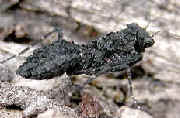
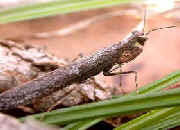
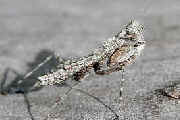
- Family Mantidae
- This family contains 80% of the Praying Mantids species found in Australia. Usually they are large in size. On their front arm, they have two rows of spines, which is different from a single row of all other families.
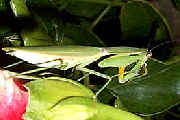
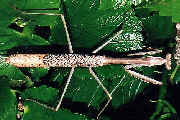
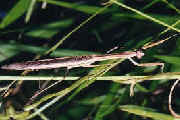
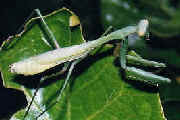

Ootheca - Mantids eggs case
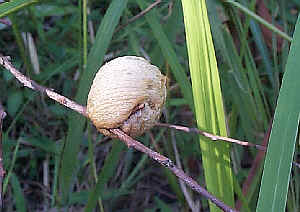
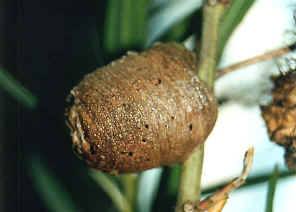
- Ootheca - Mantids eggs case of Large Brown Mantid, dia 20mm.
- The Praying Mantids are also suffer from parasitise by Parasitic Wasps. The small holes (in the second picture) were made by those wasps when they emerged.
Female mantid lays eggs in a distinctive case called ootheca. The young nymphs hatch from the ootheca can be from 10 to 100 depends on species.
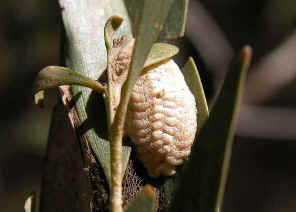
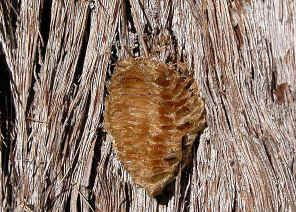
- Purplewinged Mantid Ootheca, 25mmX15mm False Garden Mantid Ootheca - Mantids eggs case, 20x25mm
Questions for Discussion
Why Praying Mantids move in step towards its prey?
- When a Praying Mantids moving towards its prey, they move in step, i.e.., they move forwards a little bit and then stop, a seconds later, it move another step and then stop, until they reach their prey. This kind of motion may be more famous in the chameleon and some of the lizards. They move in steps and stop. We can also see this kinds of movement in some spiders. This may look funny to our human eyes, but I think there is the advantage for so many animal are doing this. Since all of them are predator to insects, I spectacular that this kind of motions could be invisible to insects eyes. This kind of motions may be not sensitive to the insect eyes. So the insects predators evolutes this kind of motions to approach the prey.
When the praying mantid is very close to it prey, why it starts to swing it head side way? Why the eyes of praying mantid are separated more than other insects?
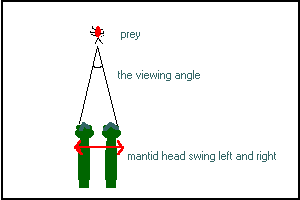
- We can also notice that when the praying mantid is very close to the prey, it start to swing it head left and right. I gauss the praying mantid doing this is to measure the distance from the prey accurately. By swinging its head, the mantid create the viewing angle with the prey, as the above picture. With the larger viewing angle, the more accurate distance can be calculated.
- The larger view angle can also explain why the praying mantids have their eyes more separated than the other insects so that they can locate precisely their prey at close distance
Here we would like to thank Graham Milledge of Australian Museum for he had kindly sent us email on correcting some mistakes in this web site.
- Reference and links:
- 1. Insects of Australia, CSIRO, Division of Entomology, Melbourne University Press, 2nd Edition 1991, pp 351-355.
- 2. Insects of Australia and New Zealand - R. J. Tillyard, Angus & Robertson, Ltd, Sydney, 1926, p93.
[ Up ] [ Family Amorphoscelidae ] [ Family Mantidae ] - 1. Insects of Australia, CSIRO, Division of Entomology, Melbourne University Press, 2nd Edition 1991, pp 351-355.
